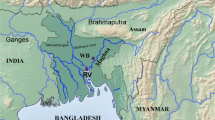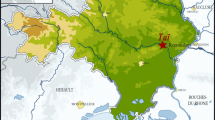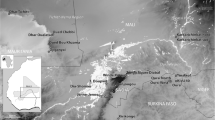Abstract
This article presents the results from a programme of bulk soil sampling and flotation of first and second millennium a.d. early farming, ‘Iron Age’, archaeological sites in Rwanda conducted in 2006–2007 alongside a new set of associated radiocarbon dates, which contribute toward the development of a chronology of plant use for the region. This research has identified the earliest examples of pearl millet (Pennisetum glaucum), finger millet (Eleusine coracana) and sorghum (Sorghum bicolor) in Great Lakes Africa and thus this article also discusses the significance of these finds within the later archaeology of the region and presents a brief synthesis of the direct archaeological evidence for finger millet in sub-Saharan Africa.








Similar content being viewed by others
References
Abdel-Magid A (1989) Plant domestication in the Middle Nile Basin: an archaeoethnobotanical case study. British Archaeological Reports, Oxford
Ambrose SH, Collett D, Modida, Marshall F (1984) Excavations at Deloraine, Rongai, 1978. Azania 19:79–104
Ashley CZ (2005) Ceramic variability and change: a perspective from Great Lakes Africa. Dissertation, University College London
Ashley CZ (2010) Towards a socialised archaeology of ceramics in Great Lakes Africa. Afr Archaeol Rev 27:135–163
Blench R (2006) Archaeology, language and the African past. AltaMira Press, Oxford
Bourlag N, Axtell J, Burton G, Harlan J, Rachie K (1996) Lost crops of Africa, vol 1, Grains. National Academy Press, Washington DC
Bronk-Ramsey C (2009) Bayesian analysis of radiocarbon dates. Radiocarbon 51:337–360
Brunken J, De Wet JMJ, Harlan JR (1977) The morphology and domestication of pearl millet. Econ Bot 31:163–174
Chrétien J-P (2003) The Great Lakes of Africa: two thousand years of history (translated by Scott Straus). Zone Books, New York
Clapham A, Rowley-Conwy P (2007) Rewriting the history of African agriculture. Planet Earth 2006:24–26
Clist B (1987) A critical reappraisal of the chronological framework of the early Urewe Iron Age industry. Muntu 6:35–62
D’Andrea AC (2008) T’ef (Eragrostis tef) in ancient agricultural systems of highland Ethiopia. Econ Bot 62:547–566
D’Andrea AC, Klee M, Casey J (2001) Archaeobotanical evidence for pearl millet (Pennisetum glaucum) in sub-Saharan West Africa. Antiquity 75:341–348
D’Andrea AC, Kahlheber S, Logan AL, Watson DJ (2007) Early domesticated cowpea (Vigna unguiculata) from Central Ghana. Antiquity 81:686–698
De Alencar Figueiredo LF, Calatayud C, Dupuits C, Billot C, Rami J-F, Brunel B, Perrier X, Courtois B, Deu M, Glaszmann J-C (2008) Phylogeographic evidence of crop neodiversity in sorghum. Genetics 179:997–1,008
De Wet JMJ, Prasada Rao KE, Brink DE, Mengesha MH (1984) Systematics and evolution of Eleusine coracana (Gramineae). Am J Bot 71:550–557
Desmedt C (1991) Poteries anciennes décorées à la roulette dans la région des Grands Lacs. Afr Archaeol Rev 9:161–196
Ehret C (1998) An African classical age: eastern and southern Africa in world history, 1000 b.c. to a.d. 400. University Press of Virginia, Charlottesville
FAO (2010) Interpolated estimated Dekadal rainfall—by region/province. Food and Agriculture Organization of the United Nations website, http://www.fao.org/giews/english/index.htm. Accessed 25 July 2010
Fuller DQ (2003) African crops in prehistoric South Asia: a critical review. In: Neumann K, Butler A, Kahlheber S (eds) Food, fuel and fields: progress in African archaeobotany. Heinrich-Barth Institute, Köln, pp 239–271
Fuller DQ (2006) Agricultural origins and frontiers in South Asia: a working synthesis. J World Prehist 20:1–86
Fuller DQ (2007) Contrasting patterns in crop domestication and domestication rates: recent archaeobotanical insights from the Old World. Ann Bot 100:903–924
Fuller DQ, Korisettar R, Vankatasubbaiah PC, Jones MK (2004) Early plant domestications in southern India: some preliminary archaeobotanical results. Veget Hist Archaeobot 13:115–129
Fuller DQ, Boivin N, Korisettar R (2007) Dating the Neolithic of South India: new radiometric evidence for key economic, social and ritual transformations. Antiquity 81:755–778
Fuller DQ, Allaby RG, Stevens C (2010) Domestication as innovation: the entanglement of techniques, technology and chance in the domestication of cereal crops. World Archaeol 42:13–28
Giblin JD (2010) Re-constructing the past in post-genocide Rwanda: an archaeological contribution. Dissertation, University College London
Harlan JR (1971) Agricultural origins: centers and noncenters. Science 174:468–474
Harlan JR (1992) Indigenous African agriculture. In: Cowan CW, Watson PJ (eds) The origins of agriculture: an international perspective. Smithsonian Press, Washington, pp 59–70
Harlan JR, De Wet JMJ (1972) A simplified classification of cultivated sorghum. Crop Sci 12:172–176
Harlan JR, Stemler R (1976) The races of sorghum in Africa. In: Harlan JR, De Wet JMJ, Stemler ABL (eds) Origins of African plant domestication. Mouton Publishers, Illinois, pp 465–478
Hather JG (2000) Archaeological parenchyma. Archetype Publications, London
Helbaek H (1969) Plant collecting, dry farming and irrigation agriculture in prehistoric Deh Luran. In: Hole F, Flannery KV, Neely JA (eds) Prehistory and human ecology of Deh Luran Plain. Memoirs of the Museum of Anthropology. University of Michigan 1, Ann Arbor, pp 383–426
Hilu KW, De Wet JMJ (1976a) Domestication of Eleusine coracana. Econ Bot 30:199–208
Hilu KW, De Wet JMJ (1976b) Racial evolution in Eleusine coracana ssp. coracana (finger millet). Am J Bot 63:1,311–1,318
Hilu KW, De Wet JMJ, Harlan JR (1979) Archaeobotanical studies of Eleusine coracana ssp. coracana (finger millet). Am J Bot 66:330–333
Hulse JH, Laing EM, Pearson OE (1980) Sorghum and the millets: their composition and nutritive value. Academic Press, London
Kahlheber S, Neumann K (2007) The development of plant cultivation in semi-arid West Africa. In: Denham T, Iriarte J, Vrydaghs L (eds) Rethinking agriculture: archaeological and ethnoarchaeological perspectives. Left Coast Press, Walnut Creek, pp 318–344
Kennedy-O’Byrne J (1957) Notes on African grasses: XXIX, a new species of Eleusine from Tropical and South Africa. Kew Bull 12:65–72
Kiage L, Liu K (2009) Palynological evidence of climate change and land degradation in the Lake Baringo area, Kenya, East Africa, since a.d. 1650. Palaeogeogr Palaeoclimatol Palaeoecol 279:60–72
Klee M, Zach B, Neumann K (2000) Four thousand years of plant exploitation in the Chad Basin of northeast Nigeria: the archaeobotany of Kursakata. Veget Hist Archaeobot 9:223–237
Klichowska M (1984) Plants of the Neolithic Kadero (Central Sudan): a palaeoethnobotanical study of the plant impressions on pottery. In: Krzyzaniak L, Kobusiewicz M (eds) Origin and early development of food producing cultures in north-eastern Africa. Polish Academy of Sciences, Poznan, pp 321–326
Lamb H, Darbyshire I, Verschuren D (2003) Vegetation response to rainfall variation and human impact in central Kenya during the past 1100 years. Holocene 13:285–292
Lane P, Ashley A, Setsonen O, Harvey P, Mire S, Odede F (2007) The transition to farming in eastern Africa: new faunal and dating evidence from Wadh Lang’o and Usenge 3, Kenya. Antiquity 81:62–81
Lange G (1991) Appendix V, a seed of wild finger millet from Gogo Falls. In: Robertshaw P. Gogo Falls. Azania 26:191–192
Maass BL, Jamnadass RH, Hanson J, Pengelly BC (2005) Determining sources of diversity in cultivated and wild Lablab purpureus related to provenance of germplasm by using amplified fragment length polymorphism. Genet Resour Crop Evol 52:683–695
Mackinder B, Pasquet R, Polhill R, Verdcourt B (2001) Flora Zambesiaca, vol 3, pt 5, Leguminosae. London, Royal Botanical Gardens at Kew. http://apps.kew.org/efloras/fz/intro.html. Accessed 25 July 2010
Manning K, Pelling R, Higham T, Schwenniger J-L, Fuller D (2011) 4500-year old domesticated pearl millet (Pennisetum glaucum) from the Tilemsi Valley, Mali: new insights into an alternative cereal domestication pathway. J Archaeol Sci 38:312–322
Nenquin J (1967) Contributions to the study of the prehistoric cultures of Rwanda and Burundi. Ann Musèe Royal de L’Afrique Centrale, Tervuren
Pearsall D (2000) Palaeoethnobotany: a handbook of procedures, 2nd edn. Academic Press, New York
Philippson G, Bahuchet S (1996) Cultivated crops and Bantu migrations in central and eastern Africa: a linguistic approach. In: Sutton JEG (ed) The growth of farming communities in Africa from the equator southwards. Azania 29:103–120
Phillips SM (1972) A survey of the genus Eleusine Gaertn. (Gramineae) in Africa. Kew Bull 27:251–270
Phillipson DW (1993) African archaeology, 2nd edn. Cambridge University Press, Cambridge
Posnansky M (1967) The Iron Age in East Africa. In: Bishop W, Clark JD (eds) Background to evolution in Africa. University of Chicago Press, Chicago, pp 629–649
Posnansky M (1973) Terminology in the early Iron Age of Eastern Africa with particular reference to the dimple-based wares of Lolui Island, Uganda. In: PanAf congress for prehistory as associated studies, vol 577–579
Posnansky M, Reid A, Ashley C (2005) Archaeology on Lolui Island, Uganda 1964–5. Azania 40:1–29
Rattray J (1960) The grass cover of Africa. FAO, Rome
Reid DAM (1996) Ntusi and the development of social complexity in southern Uganda. In: Pwiti G, Soper R (eds) Aspects of African archaeology. University of Zimbabwe Press, Harare, pp 621–628
Reimer PJ, Baillie MGL, Bard E, Bayliss A, Beck JW, Weyhenmeyer CE (2009) Intcal09 and Marine09 radiocarbon age calibration curves, 0–50,000 years cal B.P. Radiocarbon 51:1,111–1,150
Robertshaw P (1997) Munsa earthworks: a preliminary report. Azania 32:1–20
Robertshaw P, Collet D (1983) A new framework for the study of early pastoral communities in East Africa. J Afr Hist 24:289–301
Schoenbrun DL (1993) We are what we eat: ancient agriculture between the Great Lakes. J Afr Hist 34:1–31
Schoenbrun DL (1998) A green place, a good place: agrarian change, gender, and social identity in the Great Lakes region to the 15th century. James Currey, Oxford
Smith AB, Jacobson L (1995) Excavations at Geduld and the appearance of early domestic stock in Namibia. S Afr Archaeol Bull 50:3–14
Stemler AB (1990) A scanning electron microscope analysis of plant impressions in pottery from sites of Kadero, El Zakiab, Um Direiwa and El Kadada. Arch Nil Moyen 4:87–106
Taylor D, Robertshaw P, Marchant RA (2000) Environmental change and political-economic upheaval in pre-colonial western Uganda. Holocene 10:527–536
Van Grunderbeek M-C (1988) Essai d’étude typologique de céramique urewe dans la région des collines au Burundi et Rwanda. Azania 23:11–55
Van Grunderbeek M-C (1992) Essai de délimitation chronologie de L’Age du Fer Ancien au Burundi, au Rwanda et dans la région des Grands Lacs. Azania 27:53–80
Van Grunderbeek M-C, Roche E (2007) Multidisciplinary evidence of mixed farming during the early Iron Age in Rwanda and Burundi. In: Denham T, Iriate J, Vrydaghs L (eds) Rethinking agriculture: archaeological and ethnoarchaeological perspectives. Left Coast Press, Walnut Creek, pp 299–319
Vansina J (2004) Antecedents to modern Rwanda: the Nyiginya Kingdom. Currey, Oxford
Walshaw SC (2005) Swahili urbanization, trade, and food production: botanical perspectives from Pemba Island, Tanzania, a.d. 700–1500. Dissertation, Washington University in St. Louis
Walshaw SC (2010) Converting to rice: urbanization, Islamization and crops on Pemba, a.d. 700–1500. World Archaeol 42:137–154
Weber SA (1991) Plants and Harappan subsistence: an example of stability and change from Rojdi. Oxford & IBH, New Delhi
Weber SA (2001) Seeds of urbanism revisited. Antiquity 75:413–414
Westphal E (1974) Pulses in Ethiopia: their taxonomy and agricultural significance. Centre for Agricultural Publishing and Documentation, Wageningen
Wetterstrom W (1991) Appendix IV, Plant remains from Gogo Falls. In: Robertshaw P (ed) Gogo Falls. Azania 26:180–191
White F (1983) The vegetation of Africa: a descriptive memoir to accompany the UNESCO/AETFAT/UNSO vegetation map of Africa. UNESCO, Paris
Young R (1999) Finger millet processing in East Africa. Veget Hist Archaeobot 8:31–34
Young R, Thompson G (1999) Missing plant foods? Where is the archaeobotanical evidence for sorghum and finger millet in East Africa? In: Van der Veen M (ed) The exploitation of plant resources in ancient Africa. Kluwer/Plenum Publishers, New York, pp 63–72
Acknowledgments
We thank our reviewers for their constructive comments on this text. The Arts and Humanities Research Council funded the first author’s PhD research at University College London, with additional fieldwork assistance from the Institute of Archaeology Awards, University College London Graduate School, the Central Research Fund of the University of London. Assistance was also provided in Rwanda by the Institute of National Museums of Rwanda (INMR) and the British Institute in Eastern Africa. Andrew Reid supervised the first author’s doctoral research, and the radiocarbon dates were obtained through an AHRC/NERC-ORADS dating grant awarded to A. Reid.
Author information
Authors and Affiliations
Corresponding author
Additional information
Communicated by M. van der Veen.
Electronic supplementary material
Below is the link to the electronic supplementary material.
Rights and permissions
About this article
Cite this article
Giblin, J.D., Fuller, D.Q. First and second millennium a.d. agriculture in Rwanda: archaeobotanical finds and radiocarbon dates from seven sites. Veget Hist Archaeobot 20, 253–265 (2011). https://doi.org/10.1007/s00334-011-0288-0
Received:
Accepted:
Published:
Issue Date:
DOI: https://doi.org/10.1007/s00334-011-0288-0




